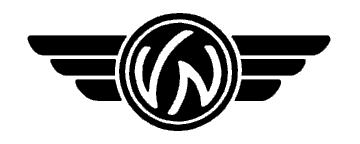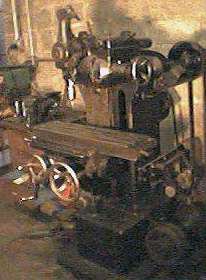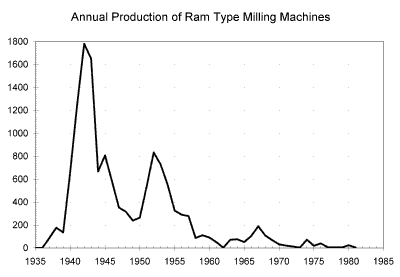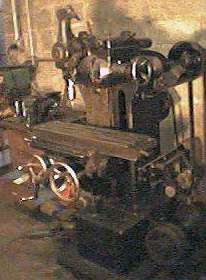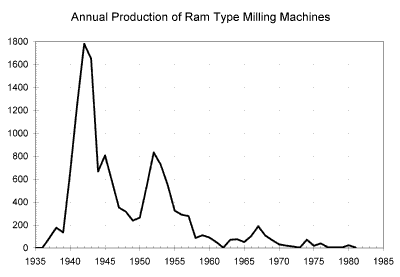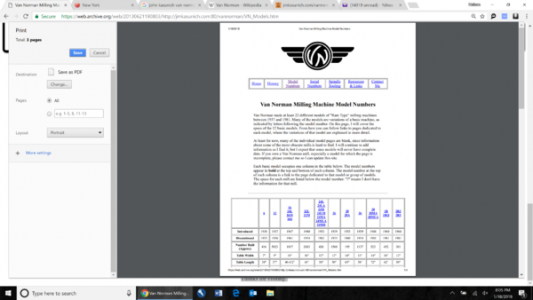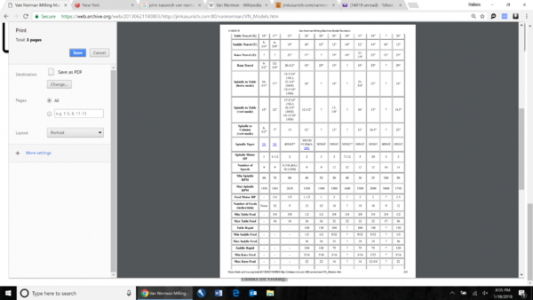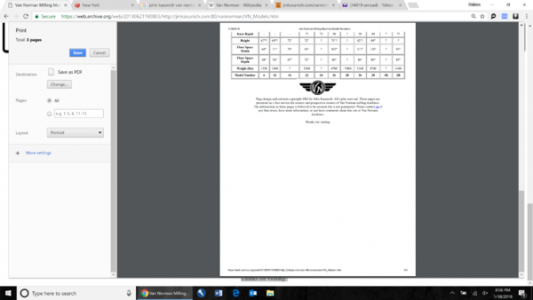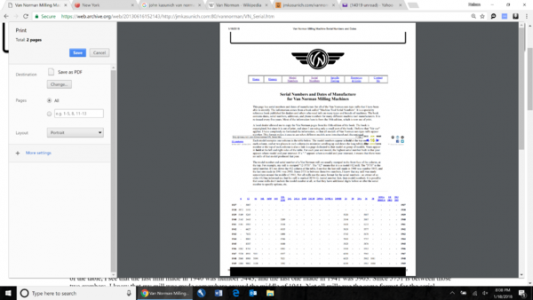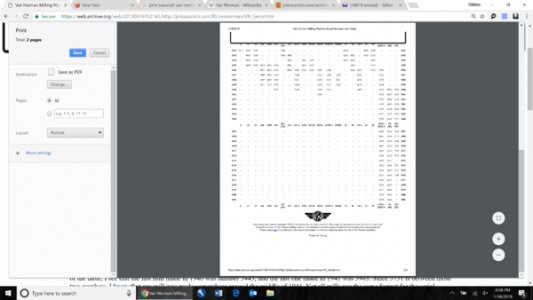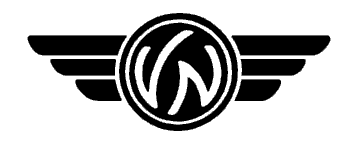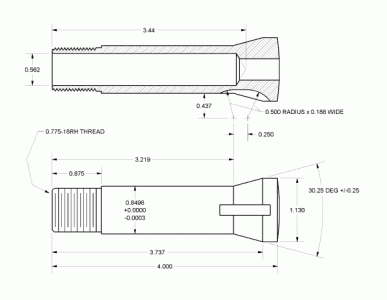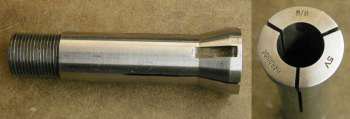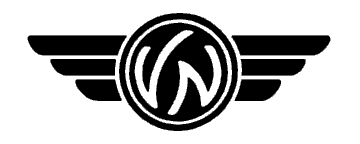- Joined
- Jan 19, 2018
- Messages
- 900
His web site is down. Used Wayback to save some of the information,
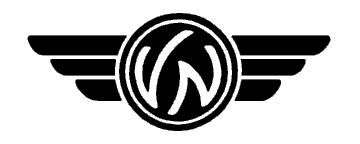
Home History Model Numbers Serial Numbers Spindle Tooling Resources & Links Contact Me

Van Norman "Ram Type" Milling Machines
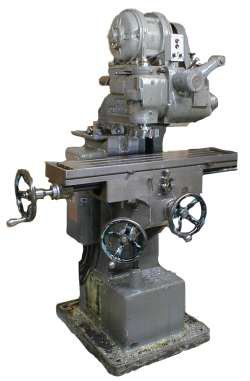 Van Norman "Ram Type" milling machines are extremely versatile alternatives to the Bridgport style vertical mills that are most common in machine shops today. The unique features of the Van Norman mills are a swiveling cutterhead and a sliding ram. Combined, these features allow the mills to be used as both horizontal and vertical mills. The other outstanding feature of these mills is their great rigidity. Pound for pound, they are much more rigid than the common vertical mills, and they can take much heavier cuts.The mill on the left is a Van Norman #12. This is the most common of the ram type mills. Over 5000 of them were made, mostly during World War II. At 1800 lbs, they are slightly smaller than a Bridgeport. This one is set up in vertical mode, with the ram forward and the cutterhead rotated to point down.
Van Norman "Ram Type" milling machines are extremely versatile alternatives to the Bridgport style vertical mills that are most common in machine shops today. The unique features of the Van Norman mills are a swiveling cutterhead and a sliding ram. Combined, these features allow the mills to be used as both horizontal and vertical mills. The other outstanding feature of these mills is their great rigidity. Pound for pound, they are much more rigid than the common vertical mills, and they can take much heavier cuts.The mill on the left is a Van Norman #12. This is the most common of the ram type mills. Over 5000 of them were made, mostly during World War II. At 1800 lbs, they are slightly smaller than a Bridgeport. This one is set up in vertical mode, with the ram forward and the cutterhead rotated to point down.

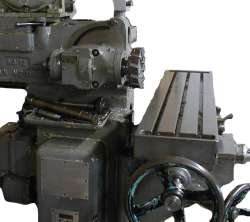 This pair of pictures shows how the Van Norman mills convert from horizontal mode to vertical mode. On the left, the mill is set up for horizontal work. The ram is moved back, and the cutterhead is rotated counterclockwise to a stop. Then the knee is raised to bring the work up to the spindle.
This pair of pictures shows how the Van Norman mills convert from horizontal mode to vertical mode. On the left, the mill is set up for horizontal work. The ram is moved back, and the cutterhead is rotated counterclockwise to a stop. Then the knee is raised to bring the work up to the spindle.
On the right, the mill is set up for vertical work. After lowering the knee to clear, the ram is cranked forward and the cutterhead rotated clockwise to the vertical stop. Converting from horizontal to vertical or back only takes a minute or two.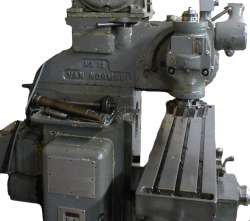


This website is intended as a resource for owners and prospective owners of Van Norman mills. If you find a mill for sale, you can look up the specs here, everything from table size to overall weight. You can figure out when it was made, what kind of collets it needs, and who might have tooling or parts. You can also check out pictures of Van Norman mills, find a manual, or read about the history of the company and the different models of ram type mills they made.
Like all web sites, this one is a work in progress. I have gathered a fair amount of information myself, and other generous individuals have supplied even more. I am always looking for more info.

Page design and contents copyright 2002 by John Kasunich. All rights reserved. These pages are presented as a free service for owners and prospective owners of Van Norman milling machines. The information on these pages is believed to be accurate but is not guaranteed. Please contact me if you find errors, have more information, or just have comments about this site or Van Norman machines.
Thanks for visiting.
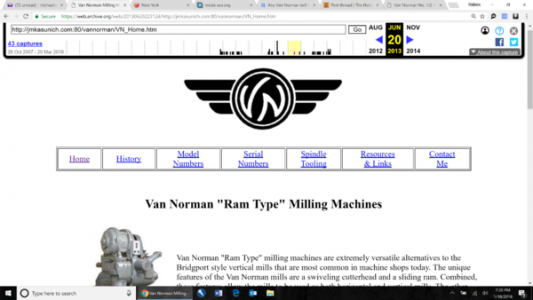



Home History Model Numbers Serial Numbers Spindle Tooling Resources & Links Contact Me

Van Norman "Ram Type" Milling Machines
 Van Norman "Ram Type" milling machines are extremely versatile alternatives to the Bridgport style vertical mills that are most common in machine shops today. The unique features of the Van Norman mills are a swiveling cutterhead and a sliding ram. Combined, these features allow the mills to be used as both horizontal and vertical mills. The other outstanding feature of these mills is their great rigidity. Pound for pound, they are much more rigid than the common vertical mills, and they can take much heavier cuts.The mill on the left is a Van Norman #12. This is the most common of the ram type mills. Over 5000 of them were made, mostly during World War II. At 1800 lbs, they are slightly smaller than a Bridgeport. This one is set up in vertical mode, with the ram forward and the cutterhead rotated to point down.
Van Norman "Ram Type" milling machines are extremely versatile alternatives to the Bridgport style vertical mills that are most common in machine shops today. The unique features of the Van Norman mills are a swiveling cutterhead and a sliding ram. Combined, these features allow the mills to be used as both horizontal and vertical mills. The other outstanding feature of these mills is their great rigidity. Pound for pound, they are much more rigid than the common vertical mills, and they can take much heavier cuts.The mill on the left is a Van Norman #12. This is the most common of the ram type mills. Over 5000 of them were made, mostly during World War II. At 1800 lbs, they are slightly smaller than a Bridgeport. This one is set up in vertical mode, with the ram forward and the cutterhead rotated to point down.
 This pair of pictures shows how the Van Norman mills convert from horizontal mode to vertical mode. On the left, the mill is set up for horizontal work. The ram is moved back, and the cutterhead is rotated counterclockwise to a stop. Then the knee is raised to bring the work up to the spindle.
This pair of pictures shows how the Van Norman mills convert from horizontal mode to vertical mode. On the left, the mill is set up for horizontal work. The ram is moved back, and the cutterhead is rotated counterclockwise to a stop. Then the knee is raised to bring the work up to the spindle.On the right, the mill is set up for vertical work. After lowering the knee to clear, the ram is cranked forward and the cutterhead rotated clockwise to the vertical stop. Converting from horizontal to vertical or back only takes a minute or two.



This website is intended as a resource for owners and prospective owners of Van Norman mills. If you find a mill for sale, you can look up the specs here, everything from table size to overall weight. You can figure out when it was made, what kind of collets it needs, and who might have tooling or parts. You can also check out pictures of Van Norman mills, find a manual, or read about the history of the company and the different models of ram type mills they made.
Like all web sites, this one is a work in progress. I have gathered a fair amount of information myself, and other generous individuals have supplied even more. I am always looking for more info.

Page design and contents copyright 2002 by John Kasunich. All rights reserved. These pages are presented as a free service for owners and prospective owners of Van Norman milling machines. The information on these pages is believed to be accurate but is not guaranteed. Please contact me if you find errors, have more information, or just have comments about this site or Van Norman machines.
Thanks for visiting.

Attachments
Last edited by a moderator:

